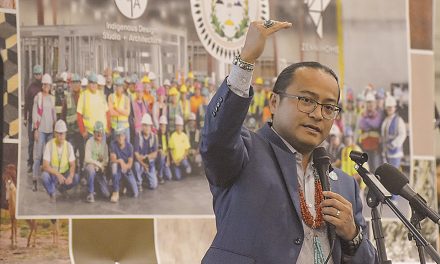
Letters: Rent is paid; thank you Joe!
My wife likes to say, “Rent is due!” when discussing the federal government’s responsibility to Native communities, and that rent has been adding up since 1492.
Ahéhee’, President Joe Biden! The United States has made a huge rent payment to indigenous peoples of the United States in the form of the American Rescue Plan recently signed into law:
- Tribal governments, $20 billion;
- Native health care, $6 billion;
- Tribal housing, $1.2 billion;
- Native education, $1.1 billion;
- Bureau of Indian Affairs, $900 million;
- Tribal infrastructure, $600 million;
- Native languages, $20 million; and
- Combat domestic violence, $19 million.
That’s not all. There’s much more in the bill for all American families, including Native Americans. The expansion of the child tax credit and earned income tax will cut the number of children in poverty in the U.S. in half.
Direct payments of $1,400 per person will be paid to individuals earning up to $75,000 and unemployment benefits will be extended until September.
Ahéhee’ to my representatives in Congress who supported the American Rescue Plan: Democratic Rep. Tom O’Halleran and Democratic senators Kyrsten Sinema and Mark Kelley.
Rent is paid! Ahéhee’, Democrats!
By the way, not one Republican supported this bill. Not one.
John G. Watts
Teec Nos Pos, Ariz.
Stray dogs are a real issue
I write this letter in response to the article in Oct. 29, 2020 (“Things look less scary for shelters after surviving a year without funds,” by Cindy Yurth), with respect for the young woman who was attacked and killed by a pack of dogs.
Although domestic violence is a grave issue on the Navajo Nation, there is a public concern: When stray dogs become feral it becomes a public health and safety risk.
It is difficult, too, when there are other pressing issues, as mentioned like domestic violence, education dwellings that are vacant due to COVID restrictions, jobs are scarce, and homelessness is on the rise.
However, the article mentioned little of the severity of the stray and feral dogs within the area around the Navajo Nation. I feel that highlights pertaining to this incident might generate public attention on the matter.
The fact is, the Navajo Nation in all its sovereignty, is notorious for stray dogs and being overpopulated with dogs. It shows a lack of pet ownership and enforcement adhering to the ordinances of responsible dog ownership set forth by Resolution of the Navajo Council: CJY-64-18 2018 and the NHA tenant policy.
In this case, it has proven ineffective as stated, “… address responsible pet ownership … through education (;) and in the spirit of cooperation through the public, other agencies and organizations for the benefit of present and future generations.”
Through education and cooperation … her death could have been avoided.
This fatal accident occurred within town limits of a heavily populated community, in a town where markets are overrun with strays. The findings were of extreme conditions. This number is not exaggerated, nor is it impressive, but excessive.
Approximately 143 dogs were put down due to this horrific incident and 44 of those dogs were involved in her death.
This number should have shocked the public and its surrounding departments. Navajo Nation Fish and Wildlife, in their professional opinion, “NHA is one of the worst areas because dogs are not chained up, strays are picked up and put down because it is hard to pinpoint where they live as they wander throughout neighborhoods.
“It is a people problem because owners do not vaccinate, microchip, spray, neuter, nor chain up and feed them.”
FBI and police say their complaints and their reports are not valued as much as the public’s.
This is nothing new. To this day, five months later, dogs continue to roam in packs. They become roadkill and litters of pups are left on the side of dirt roads.
Rescue organizations struggle to keep up but still manage to provide low-cost clinics that provide the necessary procedures and treatments to help canines live healthily.
The plans of operations delegated through the elected officials have the authority and are accountable for continuing the course of formulating plans for development and monitoring implementation.
The communities of this vast reservation have a responsibility to their animals, more importantly, to their children and the safety of the public.
Nikateesia Yazzie
Dennehotso, Ariz.
A whole chapter is gone
Today, the Navajo Nation mourns the loss of 1,233 Navajos who were exposed to COVID-19. During the past 365 days, a whole year, a Navajo chapter was eradicated from the reservation, a whole community of teachers, students, tribal leaders, rug weavers, and silversmiths, each a father, mother, brother, or sister.
These deaths can be blamed on very poor leadership. Jonathan and Myron stood by and did nothing to prevent the death of an entire Navajo chapter on the reservation.
At the beginning of this, 365 days ago, the president “closed” down the reservation by enacting curfews, closures and stay-at-home orders. These executive orders meant nothing because tribal members still were able to move about the reservation, even leaving the nation to spite the closures.
Jonathan did not enforce his orders. Myron even left the reservation for Republican rallies in Phoenix. It was very clear during the last 365 days, Jonathan was not in charge nor cared for Navajos living here on the reservation.
During the last 365 days, his orders were quickly invalidated by those shopping in Gallup at Walmart, those eating at McDonald’s in Flagstaff, and those buying televisions in Farmington. There were no roadblocks, no fines and no arrests, only superficial law enforcement.
Other tribes around the country took this seriously, using impenetrable roadblocks, providing adequate food and resources for members, and even thoroughly caring for their tribal members who were COVID-19 patients.
While the holes in the Navajo fence were gaping wide open, Jonathan, you went on tour throughout the reservation, handing out a very weak supply of food, which by my estimate, was only twice a year for each chapter.
Jonathan, your efforts were meager and self-serving. You avoided the needs. You avoided leadership. You avoided your job.
When COVID-19 exploded on the Navajo Nation, the tribe needed a leader who was willing to take charge and effectively use resources available to the Navajo Nation — private contributions, federal CARES Act funds, and partnerships with the U.S. Indian Health Service, Bureau of Indian Affairs and state and local governments.
Jonathan, you did nothing. You openly fought with the Navajo Nation Council, stood in the way of businesses who were willing to help and did nothing to enforce executive orders.
So, today, an entire Navajo Nation chapter, 1,233 members have died because of a leadership void in the tribal government. No one was there to protect these 1,233 members. No one was there to guard them from an off-reservation surge of COVID-19. No one was there to be presidential.
Next year, Jonathan will want the tribe to return him for another four more years. If he had been doing his job in the last year, that would be no problem, but today the Nation is missing 1,233 members because you never showed leadership. You never showed up for your job. You left us vulnerable with 1,233 moms, dads, sisters, and brothers missing from our tables.
Steven James
Sheep Springs, N.M.
Some suggestions for American Rescue Plan
The Times story of March 11, 2021 (“A big shot in the arm; With passage of American Rescue Plan, $20 billion for tribes on the way”) about the Navajo Nation’s share of the recently announced American Rescue Plan funds indicates that most will likely go toward water and other infrastructure projects that could not be finished during the 2020 CARES Act timeframe.
We respectfully offer a couple of ideas for spending some of whatever is left.
- Fund hataaliis and other Diné traditional practitioners — members of the hataałii associations and others.
These people are the bearers and teachers of so much Diné tradition, language, and culture, now endangered. The funding should also cover a long-overdue apprenticeship program to train desperately needed younger practitioners. All traditional Diné ceremonial practitioners are needed for the people to fully recover from the direct and indirect effects of the pandemic, as well to defend the people against future pandemics.
- Fund a Diné Youth Conservation Corps, perhaps one for each agency, which would include people 18 to maybe 30.
Also included would be knowledgeable elders and others to serve as mentors/advisors/teachers.
Together these people would team up for various projects proposed by chapters and other entities, including community wellness projects (trails, etc.), local water development, watershed/range restoration, community/school gardens, cultural education about the landscape, new capacity to cope with climate change, and continued service to needy residents with food, water, wood, etc.
Harris Francis, Window Rock, Ariz.
Klara Kelley, Gallup, N.M.
What about the schools?
Maybe while you’re applauding the Navajo Nation’s response to the coronavirus again and again, you should ask President Nez and the Department of Diné Education when they’re going to allow schools to reopen. That’s an important topic, but one that the Times has neglected lately.
The Navajo Nation is behind the rest of the country in reopening its schools. Kids need to go back to school for all sorts of reasons — educational, social, psychological — and it’s been proven that can be done safely.
Blake Gumprecht
Alamo, N.M.
NTEC must be held to account
What happened to Navajo Transitional Energy Company? The tribe had high hopes after 50 years by taking over its own mining operation to stop making non-tribal people rich.
NTEC’s birth began when professional Navajos convinced tribal officials that it was time to take over its own mining operations and to let Navajos enjoy the wealth. The days of making Peabody, BHP, APS, and SRP executives rich would be over once the tribe took over its own operation.
After several years, the opposite happened with NTEC. Today NTEC is run by non-Navajos with no Navajo executives. NTEC is now run and managed by five non-Navajos who were removed and fired from their former jobs.
The profits of NTEC, the Navajo people’s money, which are estimated at $40 million annually, are all spent in Wyoming, Montana, and Broomfield, Colorado.
The corporate office of NTEC, estimated to cost several million a year, is spent in Colorado, far from Navajo. Meanwhile, Navajo Mine workers continue to work out of old buildings built in the late 70s.
Today, the Navajo people and their communities get no part of the profits of their own coalmine. The cities and counties in Wyoming and Montana are the ones that enjoy the profits of Navajo Mine and the Navajo people’s money.
Millions annually is given to the communities of Wyoming and Montana by NTEC and their counties receive $100 million annually from taxes.
The three mines in Wyoming and Montana make no profit and have been in the red since the purchase. NTEC still doesn’t have the permits or bonds from the bankrupt mines they purchased. Layoffs monthly continue at all the northern mines.
The Navajo Tribe has little say in the operation or how the profits of the company should be spent. When NTEC goes before Council, the non-Navajos and their lawyers hide behind the legislation that created NTEC, never showing their hand. Tribal officials are not allowed to see the excessive salaries, profits, or any spending done by the executives or the board of NTEC.
The CEO, Clark Moseley, has bought off the remaining Navajo board members. Even board stipends, estimated at $100,000 annually, are kept from tribal officials’ eyes.
Tribal leadership has privately discussed over and over how to bring NTEC under control. Now NTEC is trying to buy another portion of Four Corners Power Plant. Again, NTEC executives stating clearly that they don’t need tribal approval to purchase coal assets or how to spend the Navajo people’s money.
Once again, the Navajo people suffer at the hands of non-Navajos taking advantage of Navajos’ assets.
Navajo leadership should be upset because the Navajo people are outraged. We Navajos need to do everything in our power to bring the profits of the Navajo people’s coalmine back to the Navajo people.
We should never allow NTEC non-Navajos to continue to buy fossil fuels assets without the Navajo people’s consent.
Lastly, we need to see where the Navajo people’s money is being spent from Navajo Mine.
For starters, a Navajo Nation independent audit needs to be conducted. Next, we must request the removal of the senior managers, Mr. Moseley and his people, and then replace all of NTEC board members.
We must then call individuals before the tribal leadership to testify under oath to get to the truth of the people’s coalmine.
James Yazzie
Sanostee, N.M.
Eminent domain for Shiprock pinnacle
I am here today to express my frustration with the grazing system and with the Shiprock pinnacle.
I go to the site weekly to pick up trash. I’ve been doing this for six years now. I left school in California to advocate for the pinnacle. The site is dealing with littering, vandalism and violence. These issues have been ongoing for so long.
The grazing system is the reason why the Shiprock pinnacle is not protected. They will not consent to give the site to the tribal park system.
Yet they do not pick up the littering, which is a requirement in their conservation plan to keep their grazing areas clean. So they are dishonest with their conservation plan.
Unfortunately, littering is a big issue all over the reservation. No chapter leader has been adequately logical/practical enough to address this issue.
Shiprock Chapter passed resolutions in 2009 and 2016 for the tribal park system to protect the site, but it was overturned by the grazing permittees.
I tried to work with many of the grazing permittees autonomously with alternatives such as zoning where they can still practice their grazing rights, but they didn’t even agree to those premises as well.
Yes, alternatives were presented to them. As a result, all they are doing is dictating the site by doing nothing for its environmental wellbeing.
You would think they would have the interest to preserve it because it is known to be sacred. Isn’t it sacred? If Navajo theology is correct, then the site should be honored and protected. Where are the traditionalists to speak up for the site?
At the Shiprock pinnacle, forage is dependent on the climate. Forage has been scarce at the site and there are areas where forage doesn’t grow. Yet, it is beyond me that a grazing permittee can still dictate that area.
These unutilized areas can be used. Grazing rights do need to change with the dynamics of modern environmental sciences and climate variation. Navajo agriculture does a major disservice to modern environmental sciences and is not addressing the agricultural intensification it is causing.
This grazing system is also causing environmental damage to the Chuska Mountains where grazing animals are causing havoc on the botanical life forms to grow and are disrupting the natural processes for the ecosystems to thrive. They are outcompeting the wildlife for forage and water.
Also, these grazing permittees will not allow other Navajos to have land on the Chuska Mountains.
I’m frustrated living under this radical grazing system, which prevents environmental protection, economic development, multi-utility needs, housing development, and equitable appropriation. All it is doing is causing environmental damage, radicalism for greed, and human rights atrocities to other Navajos.
I have no idea what kind of leaders are being elected because the grazing system should be the most prominent issue on the reservation that needs to be addressed. Some people vote in leaders just to protect the grazing system. We do need grazing reform and we do need leaders with backgrounds in science and formal logic to change these complicated changes.
Leaders should do their jobs and come to the site to make the observation. I shouldn’t be the one to meet with these permittees myself and address the issues. That burden falls on the leaders and that is what we elect you for.
The site needs to be protected and the decisions of these grazing permittees are just causing our tribe to be laggard. We can’t build anything or do anything because of grazing rights.
Many Navajos are in poverty and there are Navajos who travel off the reservation just to get jobs because they have no economic opportunities for them to thrive on their reservation.
The current pandemic has even exposed our economic system where Navajos still have to travel off the reservation to get their greater essential needs. We didn’t have the economics to succeed in the pandemic, which made the lockdown and its citations unjust.
A grazing permit is a deed for livestock maintenance only and it should never be used as a land title as the Navajo and polices declare. Isn’t it government land?
Most Navajos do not have a grazing permit and are being dictated to by the smaller number of Navajos with grazing permits. Most of these grazing officers just favor the permittees as well.
Nobody is speaking out against the grazing system. So I am. Please introduce and pass eminent domain for the Shiprock pinnacle, delegates.
I encourage the younger generation to speak up as well. The Navajo Nation will be your future and change is needed for you to thrive. Each Navajo should be entitled to life, liberty, and land. We need to change this radical grazing system.
Pesancio Anthony Lasiloo
Los Angeles, Calif.
Unfair to city Native
I have been living in the city since my grandparents died. To make a long story short, we have a family burial plot on my grandparent’s land and are sharing it with other family members.
I reached out to my local chapter house to rent their backhoe. Their response was it was against their religion for the operator of the backhoe to do this for me.
A couple of months ago, my family members, who live in the same area, reached out to the chapter house for help and they helped them. This was only a few months back.
I feel the way they handled the situation was insensitive and unprofessional. I don’t know if it is because I haven’t lived in the community a while or is this just basically favoritism?
I was wondering if you knew who I could make an official complaint to against the Rock Springs Chapter House. I feel I was treated unfairly for being a city Native.
Christa Yazzie
Phoenix, Ariz.








 Highway 264,
Highway 264, I-40, WB @ Winslow
I-40, WB @ Winslow